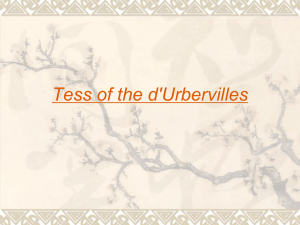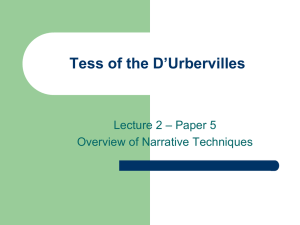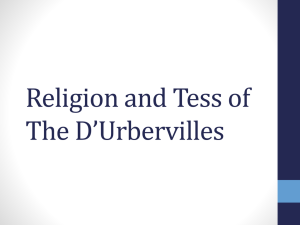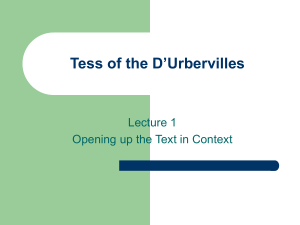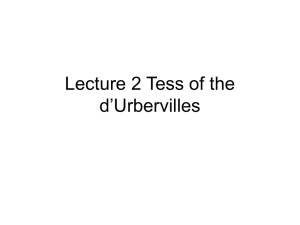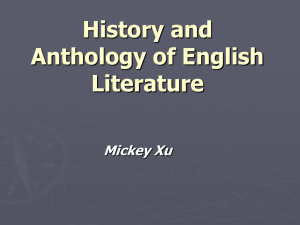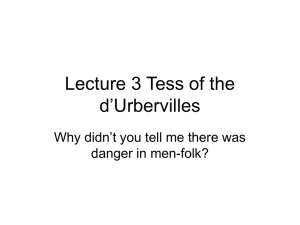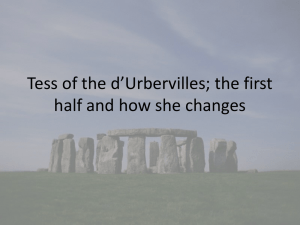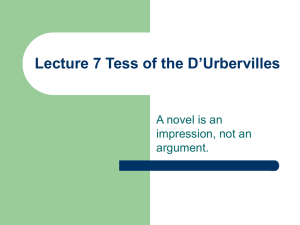L1 Tess of the D`Urbervilles
advertisement
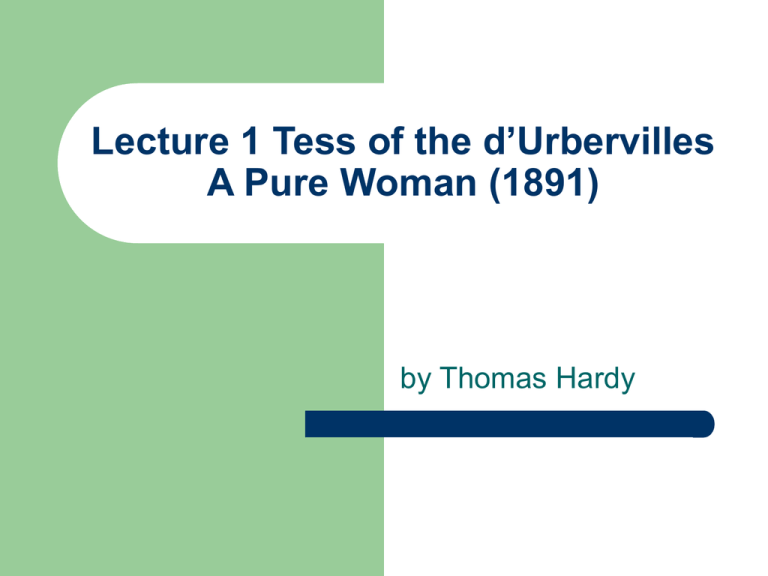
Lecture 1 Tess of the d’Urbervilles A Pure Woman (1891) by Thomas Hardy Pause and Ponder Conflict is what stories are all about. A story is a philosophy put into images. – Albert Camus (famous French writer) Focus of Lecture 1 Synopsis of the novel Some important background: Hardy the Victorian Sage, Victorian Culture and Ideas Initial pointers for reading the beginning Landscape & Symbol; Poetry in Prose Tess as a woman in literature—how is she represented? Plot Summary The novel is divided into seven sections or ‘phases’ Tess Durbeyfield, an innocent country girl, is persuaded to visit a rich family who are believed by her parents to be distant relatives. Alec d’Urbervilles, her supposed cousin, arranges for her to work as a poultry girl, and then seduces her. Cont Tess returns home to have her child, but it dies, and some years later she leaves home to work as a dairy maid on a distant farm. There she meets Angel Clare, (the son of a clergyman), who long before had seen her briefly as he passed through her village. They fall in love, and without knowing anything of her past, Clare offers to marry her; with some reluctance, Tess accepts him. Summary cont When Tess tells Clare of her past on her wedding night, he decides they must part. Angel goes to Brazil, while she goes back after a time to work on a farm. After an unsuccessful attempt to make contact with Clare’s parents, she by chance meets the man who earlier on seduced her. Alec d’Urbervilles is now reformed, and converted to being Christian preacher. Summary cont Alec offers to marry her, and abandons his preaching to follow her. In desperation, Tess writes to Clare, but, getting no reply from him, and being worn out with her work, and distressed by the hardships of her life following more especially her father’s death, she is eventually won back to Alec. Summary cont When Clare finally does return home, he finds his Tess living with Alec in lodgings in a seaside town on the south coast of England. Ashamed at having given way to Alec’s persuasiveness, and full of remorse for having despaired of her husband, Tess murders Alec with a carving knife and follows Clare. Plot summary concluded: For some days Tess and Angel Clare live together in an empty house in the country; Disturbed, they take to the road again, and are found at the ancient monument, Stonehenge, by policemen. The police arrest Tess. For the murder of Alec, Tess is HANGED. Note the novel’s stark ending. Thomas Hardy (1840-1928) Novelist, Poet, and Victorian Sage Hardy went to the theatre, the opera, and especially to art galleries. He kept a notebook on painters and paintings Had a gift for keen visual observation which begun in the countryside and further trained in architecture, as well as through his love for art Hardy as Victorian Sage Intellectually, Hardy was a very advanced man for his time. He kept up with new ideas and new advancements in politics, philosophy and science; Ideas of Comte, Charles Darwin, John Stuart Mill, Thomas Henry Huxley, Herbert Spencer Making it almost impossible to retain the notion of a transcendent, governing Providence Thus giving rise to his pessimistic outlook on life Hardy’s Victorian Century and its intellectual ferment Darwin and Darwinism; Darwin’s Origin of Species (1859); first book to support the evolutionary hypothesis with a mass of scientific evidence. A new view of nature—each new advance in biology and geology seemed to show that Nature was “Red in tooth and claw.” Hardy was one the first readers of Darwin Feeling the “ache of modernism” The emerging new picture—that no God entered beneficently into this bleak, disorderly and destructive state of affairs Disillusioned view of Life: Hardy reflects this agonizing picture of nature in his novels. Since there is no God to give meaning to life, Man is alone in the Universe, no better off and no worse off than other creatures There is no divine plan; It’s a world of matter; Everything happens by blind chance; The universe is indifferent to humanity, to our joys and our sorrows; The human is thus more a victim of forces within oneself, and the environment. Hardy’s Atheism? Agnosticism? Hardy thus could find no easy comfort in orthodox Christian religious belief. He even wrote a poem entitled ‘God’s Funeral.’ TD as a novel, attacks the churches and their clergy for making promises of redemption that Hardy believes can not be fulfilled. Humankind is at the mercy of an unheeding universe; an unheeding world of Nature; ‘we be on a blighted star’ (Chapter 4) Nature does not often say ‘See!’ (Chapter 4) “Blind chance” is the way of the world What little happiness there is… One thread which does seem to run through Hardy’s writing — Times of happiness are elusive and fleeting And therefore to be cherished e.g. Tess’s time as a milk maid at Talbothays’ Dairy That love and friendship are fragile But amongst the most precious of human experiences There is a deep compassion for those whom life has treated badly. Most memorable characters are sufferers, characters such as Tess, and her family; Victims partly of their own weakness and partly of circumstance, Which we may choose to call Fate or Chance The natural world exacts its full penalty in the consequences of misfortunes and wrong choices; That is the essence of tragedy Tess is the story of a girl doomed to misery in an indifferent world, despite being good. Hardy is celebrated as a great tragic writer A Christian theocentric world view The mass of ordinary people continued to believe in a beneficent, divine creator Believed in the commandments of the Bible Victorian culture and the cult of chastity Tess falls. She violates the Christian based moral codes and conventions of her time. But she is an absolute victim of circumstances, and thus beyond their stain Keep in mind Throughout the novel, Tess is portrayed as a part of nature And that though society may judge her to have “fallen” Nature cannot do so. Walking, traveling, movement? ‘On an evening in the latter part of May a middle-aged man was walking homeward from Shaston to the village of Marlott, in the adjoining Vale of Blakemore or Blackmoor.’ Novel opens with a description of a man staggering on ‘rickety’ legs down a road. ‘There was a bias in his gait which inclined him somewhat to the left of a straight line.’ Reading with Insight— the opening of Chapter 1 It is John Durberfield’s daughter, Tess, we will see walking throughout the novel. Always Tess has to walk, to move, usually to harsher and more punishing places Her walking gets harder and nearer darkness We see her too on ‘rickety’ legs, staggering And always to the left of that straight line Landscape as Symbol in TD The geographical landscapes of TD have a symbolic purpose Each provides the frame and background for the stages in the life of Tess They function as external symbols, (symbolizing the interior experiences of her soul) [Intended Effects] Place and season guide the reader’s response Sound and Sense: Language of Hearing Hardy’s prose is that of a poet; Hardy believed that good prose should have a poetic quality ‘The shortest way to good prose is by the route of good verse.’ Hardy has a good ear for sound owing to his experience of music. Watch out, LISTEN for, sonic effects Symbolical Significance of title: Tess of the D’Urbervilles The Rural and the Urban ‘Urbs’ in Latin, means ‘City’ ‘Ville’ in French, means ‘Town’ Tess Durbeyfield (ordinary country girl Becomes Tess D’Urberville


